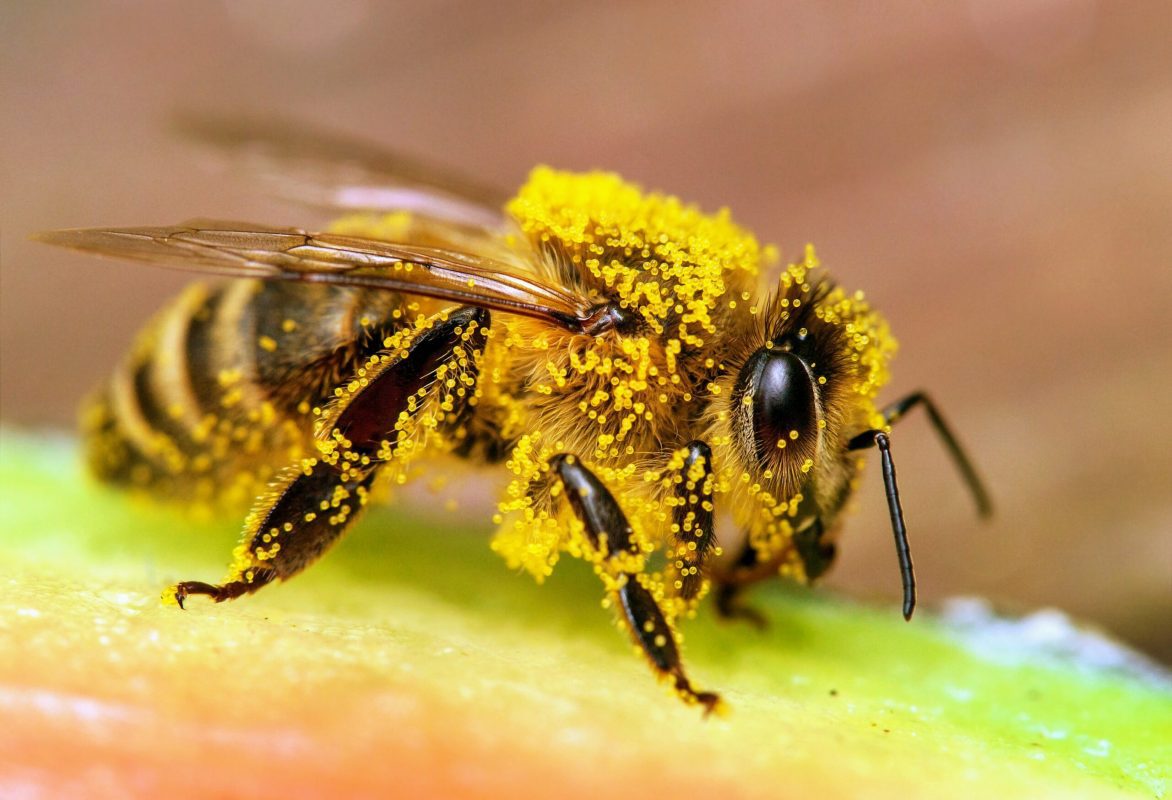Bee Bread, Bee Pollen, Health
The Benefits of Bee Products for The Human Body
Bee bread contains many vitamins: C, B1, B2, E, H (biotin), P (rutin), nicotinic, pantothenic, folic acids. Bee bread also contains other substances: enzymes (sucrose, amylase, various aminotransferases, phosphatases, etc.), organic acids, hormones, pigments, and other compounds with antibiotic properties.
The totality of such substances, which are important for the body’s vital processes, determines the biostimulating effect of bee bread. Bee bread removes physical and mental fatigue, improves mood, supplements deficiencies of vitamins and microelements, is suitable for restoring strength after various illnesses, strengthens the immune system, regulates disturbed activity of the digestive tract, helps with atherosclerosis, is suitable for the prevention of anemia, treatment of cardiovascular disorders, helps with illness diabetes.
The unique value of bee products is due to the fact that they are natural stimulators of vital processes, capable of mobilizing the body’s protective forces and helping to deal with the disease independently. Each bee product contains more than 300 different natural balanced components, which is why they provide a multifaceted beneficial regulatory effect on the human body. This is very important in times of tension and high stress loads.
Bee products – honey, propolis, pollen, bread, etc. are distinguished by their biologically active substances, have an exceptionally valuable therapeutic effect, and as a universal biogenic stimulant, they are irreplaceable. Bee products have specific antimicrobial, antiviral activity, anti-radiation and anti-inflammatory properties, normalize the activity of internal organs, blood vessels, brain and peripheral nervous system. The active substances contained in bee products are more active than most used analogues in the treatment of wounds, burns and frostbite.
Pollen and bee bread are very useful products that influence the removal of poisons from the body, including lead compounds, heavy metals, they especially increase the working capacity and endurance of the human body, strengthen the immune system, thus creating more opportunities in the fight against serious diseases or strengthening children’s and health of adults living in ecologically unfavorable regions.
Pharmacological properties of pollen and bee bread
Immunostimulating – characterized by the fact that it activates cellular immunity. This property is characteristic of pollen protein hydrolyzate and bee bread. It should be noted that the activity of bee pollen is almost twice as high as that of pollen. When using pollen or bee bread, the phagocytic activity of absolute and relative amounts of T- and B-lymphocytes and neutrophils was determined.
Regulating effect on intestinal peristalsis occurs in the treatment of chronic colitis. The evacuation function of the intestine normalizes regardless of the type of dyskinesia.
Adaptogenic effect is the ability to increase the body’s resistance in the presence of unfavorable physical, chemical and psychological factors. This effect is characteristic of pollen and uncharacteristic of their lipophilic, hydrophilic and ethanolic extracts.
K. Kadziauskienė and others. (1991) studied 20 biochemical parameters of blood and liver of animal samples that revealed adaptogenic and antitoxic properties of pollen. These properties were manifested when animals were administered a lipophilic or ethanolic extract, as well as when using a hydrophilic solution of bee bread against the background of nitrate or fluoride intoxication.
Antimicrobial effect – this effect was found in pollen in the 20th century by Chauvin et al. Lenormand. Pollen has a more active effect on bacteria: rods, salmonella, shigella, followed by bacillus and least staphylococci. Antimicrobial activity also depends on the plant species.
Antianemic effect. K. V. Savilovas and others. (1991) found that pollen stimulates erythrocytes and leukopoiesis in various experimental models of anemia, which proved to be more effective than traditional hematopoietic stimulants such as folic acid, iron preparations, vitamin B12. As a result, pollen is recommended for various forms of anemia and leukopenia. The effect of pollen is determined together with the anabolic effect and the influence of the complex of trace elements – iron, cobalt, copper, which are involved in hematopoietic processes.
The membrane-stabilizing effect is manifested by the fact that the unsaturated fatty acids and phospholipids in pollen, which are structural components of cell membranes, regulate their membrane permeability.
Cardiotonic effect – manifested by a balanced set of minerals: potassium, calcium, phosphorus, magnesium, etc. These trace elements strengthen the normal functioning of the heart. In addition, B group vitamins present in pollen and bread are also of great importance in realizing the cardiotonic effect, which are manifested by versatile metabolic activity. Therapeutic doses of pollen (25 – 30 g) meet the daily human need for vitamins B1, B2, B9 and B3 and folic acid.
Antiatherosclerotic effect – the polyunsaturated fatty acids in the pollen reduce the cholesterol level in the blood, prevent the accumulation of cholesterol on the blood vessel walls, are cholesterol antagonists.
Antioxidant effect – prof. Antonio Radryguez Molaver (2007) analyzed the particularly valuable antioxidant, vasodilatory, anticarcinogenic, anti-inflammatory, antibacterial, antiallergic, antiviral, estrogenic and immunostimulating properties of pollen. He suggested that most of these properties depend on the polyphenolic compounds found in the pollen.
Anti-lipidemic effect – many studies have shown that omega-3 fatty acids, which are found in large quantities in pollen and bread, effectively correct the disturbed blood lipid balance: they reduce the amount of triglycerides in the serum by 21-79 percent, and the amount of cholesterol by 34-65 percent, the amount of high-density lipoprotein cholesterol increases by 18 percent. As indicated by Dr. R. Zaleckis (2009), triglycerides and low-density lipoprotein cholesterol decrease because omega-3 fatty acids inhibit the synthesis of triglycerides and apolip-protein in the liver, activate the removal of low-density lipoprotein cholesterol from the body, stimulate the release of bile acids (cholesterol catabolism products) and disposal with faeces.
Antithrombotic effect. Research in recent years has shown that omega-3 fatty acids also have an antithrombotic effect, and this effect is related to the competitive inhibition of arachidonic acid in cell membranes. Prostaglandins, thromboxanes, leukotrienes are synthesized from arachidonic acid. Thromboxane A2 is a powerful vasoconstrictor and inducer of platelet aggregation.
Antihypertensive effect – omega-3 fatty acids have been shown to reduce elevated arterial blood pressure and inhibit the hypertensive response to noradrenaline. The antihypertensive effect of the mentioned acids is mild, moderate and depends on the dose.
The antiarrhythmic effect is related to the property of omega-3 fatty acids, which promotes the accumulation of eicosapentaenoic acid in platelet membranes and microsomes of myocardial cells, activates Ca – Mg – ATF-ase in cell membranes, reduces myocardial ischemia, increases its resistance to ischemia and improves performance in conditions of oxygen deficit, reduces the likelihood of life-threatening arrhythmias.
Anti-inflammatory effect. The anti-inflammatory action of omega-3 fatty acids is clinically very important, because the significance of inflammatory reactions in the pathogenesis of atherosclerosis is unquestionable. Inhibition of inflammation affects the normalization of endothelial function and stabilization of atherosclerotic plaques.
Dr. R. Zaleckis indicates other properties of omega-3 fatty acids:
– improves blood rheological properties, reduces viscosity,
– increases the plasticity of erythrocytes,
– activates fibrinolysis,
– reduces the amount and activity of thrombogenic and plasma substances,
– reduces the activity and amount of adhesion molecules on the surface of the endothelium,
– inhibits the activity of platelets,
– stimulates the synthesis and release of endothelium-dependent relaxation factor, thus normalizing the kinetic function of blood vessels,
– suppresses the vasospastic response of blood vessels to the effects of catecholamines.



